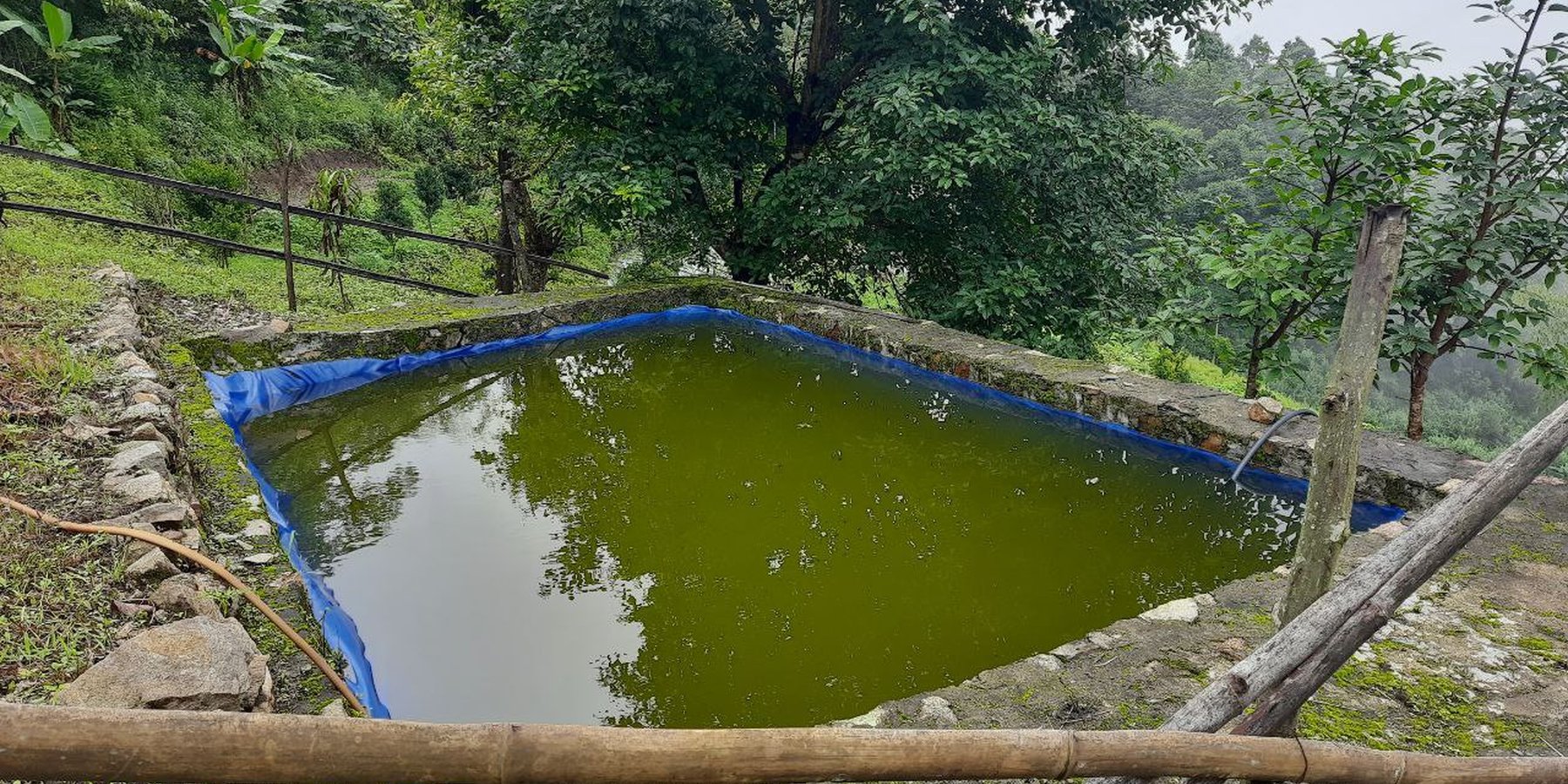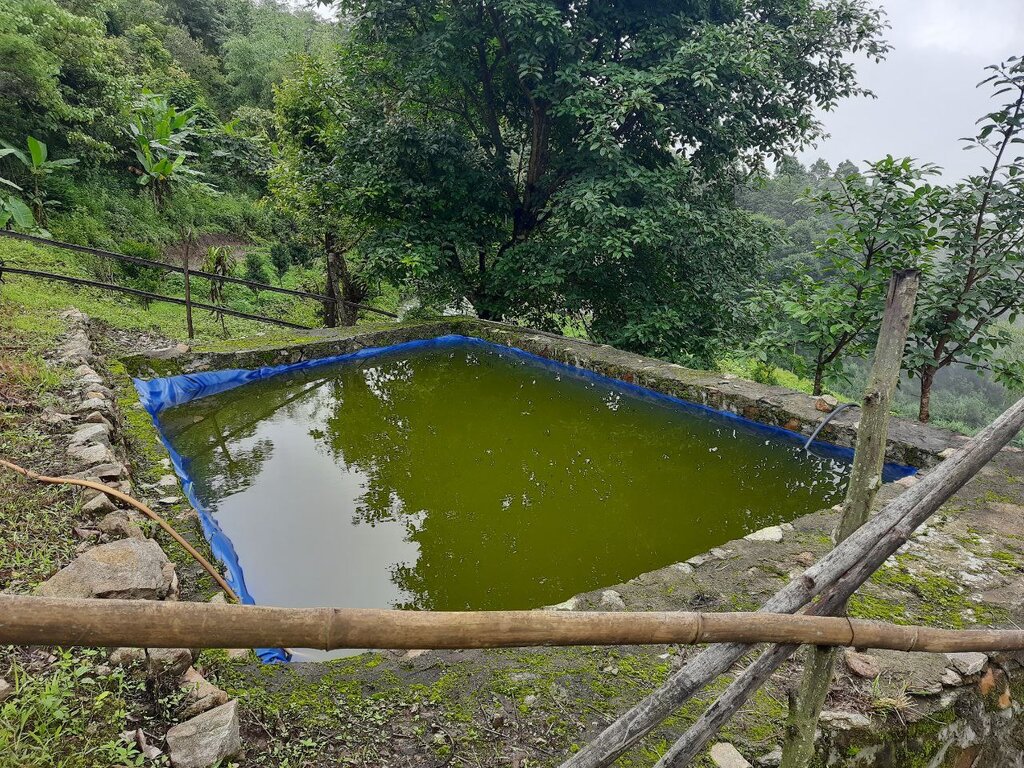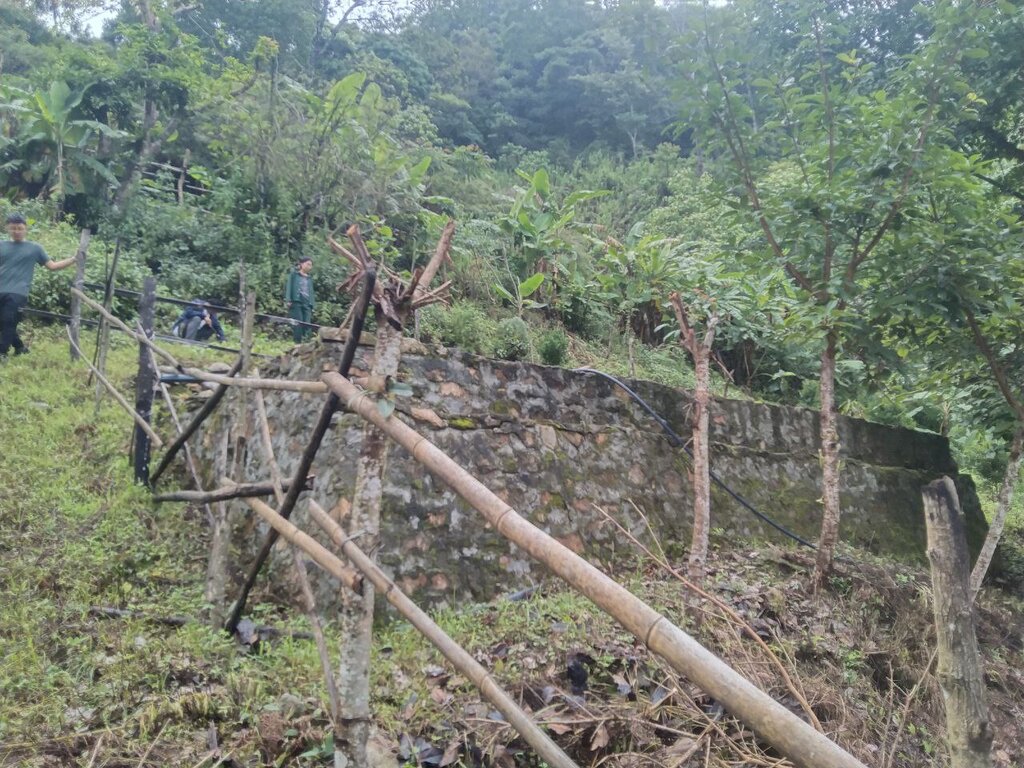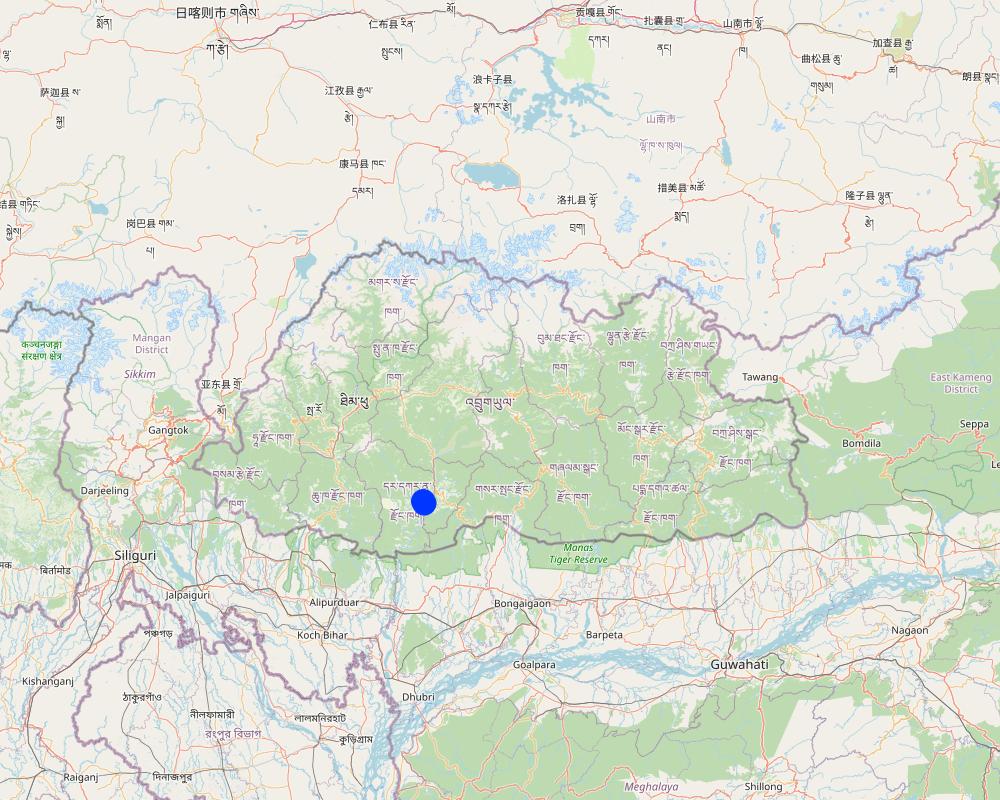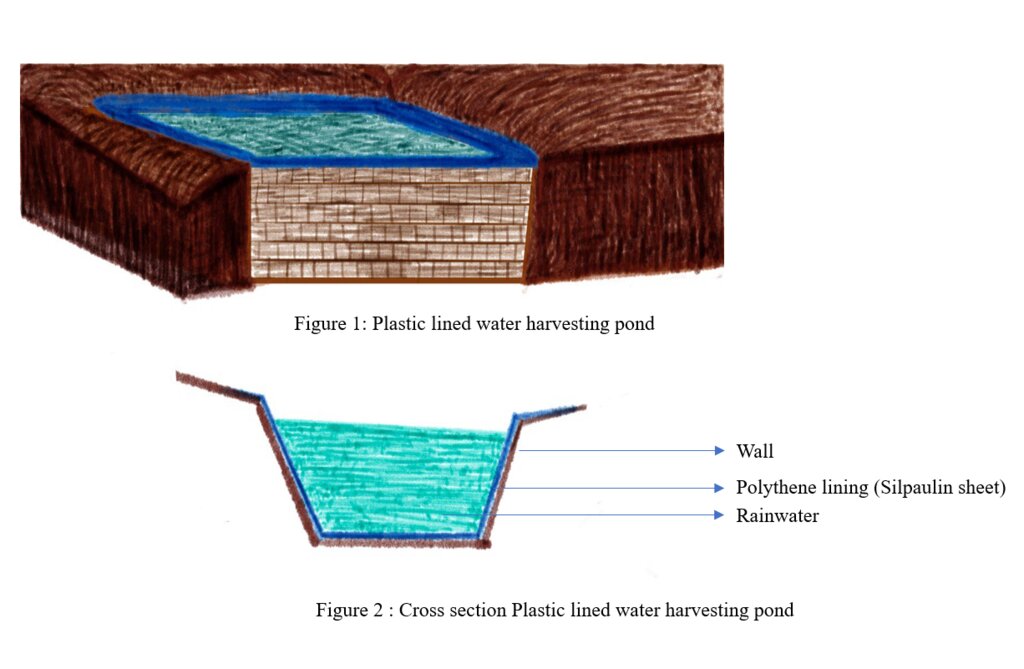Low-Cost Plastic-Lined Water Harvesting Pond [Bhoutan]
- Création :
- Mise à jour :
- Compilateur : Nima Dolma Tamang
- Rédacteur : Kuenzang Nima
- Examinateurs : William Critchley, Rima Mekdaschi Studer
Chhu-zing
technologies_6821 - Bhoutan
Voir les sections
Développer tout Réduire tout1. Informations générales
1.2 Coordonnées des personnes-ressources et des institutions impliquées dans l'évaluation et la documentation de la Technologie
Personne(s)-ressource(s) clé(s)
exploitant des terres:
Sangay
Bhoutan
Nom du projet qui a facilité la documentation/ l'évaluation de la Technologie (si pertinent)
Strengthening national-level institutional and professional capacities of country Parties towards enhanced UNCCD monitoring and reporting – GEF 7 EA Umbrella II (GEF 7 UNCCD Enabling Activities_Umbrella II)Nom du ou des institutions qui ont facilité la documentation/ l'évaluation de la Technologie (si pertinent)
National Soil Services Centre, Department of Agriculture, Ministry of Agriculture & Livestock (NSSC) - Bhoutan1.3 Conditions relatives à l'utilisation par WOCAT des données documentées
Le compilateur et la(les) personne(s) ressource(s) acceptent les conditions relatives à l'utilisation par WOCAT des données documentées:
Oui
1.4 Déclaration sur la durabilité de la Technologie décrite
Est-ce que la Technologie décrite ici pose problème par rapport à la dégradation des terres, de telle sorte qu'elle ne peut pas être déclarée comme étant une technologie de gestion durable des terres?
Non
1.5 Référence au(x) Questionnaires sur les Approches de GDT (documentées au moyen de WOCAT)
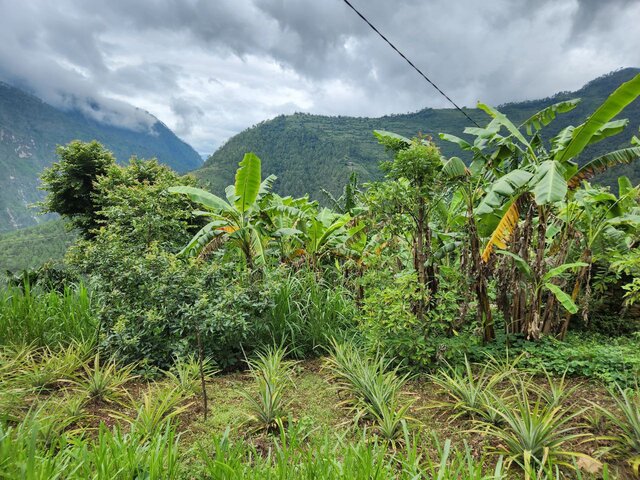
Climate-Smart Village Approach [Bhoutan]
Climate change has become inevitable, and there is a need to address this impending danger. In the Climate-Smart Village (CSV) approach, land users in Ngaru-Pongtang have implemented several technologies and innovations to address climate change impacts, and the programme has worked with 50 households on a total area of 137 …
- Compilateur : ONGPO LEPCHA
2. Description de la Technologie de GDT
2.1 Courte description de la Technologie
Définition de la Technologie:
Low-cost plastic-lined water harvesting ponds collect and store rain and overland flow water for agricultural and domestic purposes in the dry season. They are both economic and efficient.
2.2 Description détaillée de la Technologie
Description:
Low-cost plastic-lined water harvesting pond are used to collect and store rain or overland flow water for agricultural purposes in the dry season. They are economic and efficient. These ponds are required in the context of irrigation water shortages. Although rainfall has been projected to be increasing (NCHM, 2017), irrigation water shortage was - and continues to be - one of the major constraints in crop production (IHPP, 2017).
Water from precipitation and surface water sources is lost due to inadequate collection and storage. Villages at the top of the hills, in particular, suffer from acute irrigation as well as drinking water shortages. To tap and collect wastewater, rainwater, and water from other perennial and non-perennial sources, low-cost plastic lined water harvesting ponds are proposed. This water can be used during the dry or “lean” season for agricultural as well as household purposes.
The proposed model pond (plastic sheet size; 9m * 7m) costs less than Nu. 25, 000 (USD 315) for construction but can hold more than 27, 000 litre of water. The same dimension of pond if constructed using concrete, would cost more than Nu. 1, 19, 000 (USD 1500). Furthermore a 10, 000 litre synthetic tank available on the market costs more than Nu.35, 000.
Irrigation water shortage results in fallow lands. It is reported that 6,400 acres (2,600 ha) of irrigable land was left fallow in 2016 and 26 % of the total households surveyed were affected by irrigation water shortages (DoA, 2016). By reducing fallow land and increasing crop production, this technology could be a stepping stone towards food self-sufficiency – as well as providing water for consumption by people and livestock.
Though a similar technology is said to have introduced in the country many years ago, the present form of the technology was introduced to Barshong gewog in Tsirang Dzongkhag by the ‘Himalica’ pilot project in 2014. However, the proposed technology has been modified and improved to suit to the topography and needs of farmers in Bhutan. The proposed pond design is a reverse truncated square pyramid shape unlike the cuboid shape ponds of ICIMOD’s. The pond is designed in such way as to increase pond stability and ease of construction.
Concrete tanks require specific construction methods and faults can develop with ice freezing and expanding in cracks in tank walls during the winter (Slater, 2011). Plastic (silpaulin) sheet lined ponds are leak-proof and primarily depend on the longevity of the plastic sheet unlike concrete tanks. Concrete water tanks, (especially elevated tanks) are also prone to damage due seismic activities (Housner, 1963).
The low-cost plastic lined water harvesting pond adopted is cheap, environmentally friendly, and has positive social impacts. It reduces irrigation water constraints, addresses fallow land problems, and supplements water for domestic purposes. The technology is a tool for reducing poverty, expanding cultivated land and increasing food self-sufficiency resulting in a healthier and happier society.
2.3 Photos de la Technologie
2.5 Pays/ région/ lieux où la Technologie a été appliquée et qui sont couverts par cette évaluation
Pays:
Bhoutan
Région/ Etat/ Province:
Dagana Dzongkhag
Autres spécifications du lieu:
Pangserpo Chiwog, Drujeygang Gewog
Spécifiez la diffusion de la Technologie:
- appliquée en des points spécifiques ou concentrée sur une petite surface
Est-ce que les sites dans lesquels la Technologie est appliquée sont situés dans des zones protégées en permanence?
Non
Commentaires:
The technology is located in the land users field.
Map
×2.6 Date de mise en œuvre de la Technologie
Indiquez l'année de mise en œuvre:
2019
2.7 Introduction de la Technologie
Spécifiez comment la Technologie a été introduite: :
- par le biais de projets/ d'interventions extérieures
Commentaires (type de projet, etc.) :
The technology was initiated by Agriculture Research and Development Centre Bajo through fund support of Food Security and Agriculture Productivity Project of the World Bank. Drujegang, Kana and three blocks of Lhamoidzingkha sub-district of Dagana districts were selected as the project sites.
3. Classification de la Technologie de GDT
3.1 Principal(aux) objectif(s) de la Technologie
- améliorer la production
- réduire, prévenir, restaurer les terres dégradées
- s'adapter au changement et aux extrêmes climatiques et à leurs impacts
- créer un impact économique positif
- créer un impact social positif
3.2 Type(s) actuel(s) d'utilisation des terres, là où la Technologie est appliquée
Les divers types d'utilisation des terres au sein du même unité de terrain: :
Oui
Précisez l'utilisation mixte des terres (cultures/ pâturages/ arbres):
- Agroforesterie

Terres cultivées
- Cultures annuelles
- Plantations d’arbres ou de buissons
Cultures annuelles - Précisez les cultures:
- légumineuses et légumes secs - fèves
- plantes à racines et à tubercules - pommes de terre
- légumes - légumes à feuilles (laitues, choux, épinards, autres)
- légumes - autres
- légumes - légumes-racines (carotte, oignon, betterave, autres)
- chilli, onion
Plantations d'arbres et d'arbustes - Précisez les cultures:
- citron
Nombre de période de croissance par an: :
- 2
Est-ce que les cultures intercalaires sont pratiquées?
Oui
Si oui, précisez quelles cultures sont produites en culture intercalaire:
Vegetables intercropped within citrus orchard
Est-ce que la rotation des cultures est appliquée?
Oui
Si oui, veuillez préciser:
The land users grow different crops in the same area. For example, if they plant potatoes this year, they plant beans next year.
3.3 Est-ce que l’utilisation des terres a changé en raison de la mise en œuvre de la Technologie ?
Est-ce que l’utilisation des terres a changé en raison de la mise en œuvre de la Technologie ?
- Non (Passez à la question 3.4)
3.4 Approvisionnement en eau
Approvisionnement en eau des terres sur lesquelles est appliquée la Technologie:
- mixte: pluvial-irrigué
3.5 Groupe de GDT auquel appartient la Technologie
- récupération/ collecte de l'eau
- gestion de l'irrigation (incl. l'approvisionnement en eau, le drainage)
3.6 Mesures de GDT constituant la Technologie

structures physiques
- S5: Barrages/retenues, micro-bassins, étangs
- S7: Collecte de l'eau/ approvisionnent en eau/ équipement d'irrigation
3.7 Principaux types de dégradation des terres traités par la Technologie

érosion hydrique des sols
- Wt: perte de la couche superficielle des sols (couche arable)/ érosion de surface

dégradation hydrique
- Hs: changement de la quantité d’eau de surface
3.8 Prévention, réduction de la dégradation ou réhabilitation des terres dégradées
Spécifiez l'objectif de la Technologie au regard de la dégradation des terres:
- réduire la dégradation des terres
- restaurer/ réhabiliter des terres sévèrement dégradées
4. Spécifications techniques, activités, intrants et coûts de mise en œuvre
4.1 Dessin technique de la Technologie
Spécifications techniques (associées au dessin technique):
Site selection for pond construction:
Choose a site for the pond at the top of the farm for easy flow/use of water to the agricultural fields. Select the site only at the stable soils to avoid collapse, and bursting of the pond. Water sources for the pond may be perennial water sources, rainwater gutter systems, water from tap stand, and waste water from farm house or a combination of the different sources.
Materials required: The materials required for making the pond are:
1.Plastic sheet of desired length and breadth
a.250-300 GSM (gram per square meter)]
b.UV stabilized
2.Measuring tape (30m)
3.Shovel, spade, and crowbar
4.Mosquito net or similar ones
5.HDPE pipes, gates valves
6.Fencing materials (bamboo poles, wooden poles, barbed wire, nails, wire mesh, binding wire)
Procedure to dig the pond:
1.Clear the vegetation and level the ground to construct the harvesting pond.
2.Measure the base length (l), and the base breadth (b) on the leveled ground. These length and breadth will be the length and breadth of the pond floor. Dig out the soil till 1.2 m height (h) to construct a cuboidal pond.
3.From the top edges of the cuboidal pond, measure distance ‘g’ in all four sides. Make slanting cuts from the top to the base on all four sides. Scrap off soils on all sides to obtain slope of 700. The gradient is made for slope stabilization and convenience to lay out plastic sheet.
4.Make the cut surfaces including the floor smooth by using mud and cow dung paste or mud paste in order to avoid damages to the plastic sheet while laying out and when filled with water. The pit ready to lay out plastic sheets should have the dimensions.
5.Carefully lay out the plastic sheet over the pit. Keep an anchor length (overlap) of 0.5m on all sides of the pit. Fix wooden or bamboo pegs or iron rod through the eyelets of the plastic sheet and or cover the overlapping plastic edges by at least 10cm of mud or soil to strongly anchor the plastic sheet.
6.Construct a drain with 30cm width and 30cm depth around the edges of the plastic sheet which was covered with soil or mud. The drainage should slope towards a suitable drain out area.
7.Fence the pond using wire mesh/bamboo/wooden poles/timber to prevent mishaps or accidents. Fill the pond with water only after fencing. Galvanized wire mesh is preferable.
Using water:
Water from the pond can be used in the following ways:
Directly siphoning off with a pipe
Pumping up with a small motor pump
Taking out with suitable containers
Inserting a drain out pipe at one of the base corners.
The insertion of the drain out pipe should be done during the construction of the pond.
Note: The stone wall may be required in specific situations if built in a slope like this one but not generally needed. Technical drawing of the water harvesting pond without the cement structure is available at http://rcbajo.gov.bt/leaflet/ also shared under section 7 of this document.
Auteur:
Ongpo Lepcha
Date:
08/12/2023
4.2 Informations générales sur le calcul des intrants et des coûts
Spécifiez la manière dont les coûts et les intrants ont été calculés:
- par entité de la Technologie
Précisez l'unité:
water harvesting pond
Précisez les dimensions de l'unité de terrain (le cas échéant):
41.6 cubic metre
autre/ monnaie nationale (précisez):
Ngultrum (Nu.)
Indiquez le taux de change des USD en devise locale, le cas échéant (p.ex. 1 USD = 79.9 réal brésilien): 1 USD = :
80,0
Indiquez le coût salarial moyen de la main d'œuvre par jour:
Ngultrum 350
4.3 Activités de mise en place/ d'établissement
| Activité | Calendrier des activités (saisonnier) | |
|---|---|---|
| 1. | Surveying and site selection | Anytime |
| 2. | Procuring materials | Anytime after surveying |
| 3. | Construction of pond | Dry season |
| 4. | Fencing | After completion of water harvesting pond |
| 5. | Monitor | Checking water level, infestation of mosquitoes and checking safety measures like fencing and leakages |
4.4 Coûts et intrants nécessaires à la mise en place
| Spécifiez les intrants | Unité | Quantité | Coûts par unité | Coût total par intrant | % du coût supporté par les exploitants des terres | |
|---|---|---|---|---|---|---|
| Main d'œuvre | Construction of pond | Person-days | 8,0 | 500,0 | 4000,0 | 100,0 |
| Matériaux de construction | HDPE pipe | Metre | 100,0 | 40,0 | 4000,0 | 100,0 |
| Matériaux de construction | Wire mesh | Pieces | 2,0 | 3500,0 | 7000,0 | |
| Matériaux de construction | Silpaulin plastic sheet | Pieces | 1,0 | 7500,0 | 7500,0 | |
| Matériaux de construction | Wooden post | Pieces | 14,0 | 60,0 | 840,0 | 100,0 |
| Coût total de mise en place de la Technologie | 23340,0 | |||||
| Coût total de mise en place de la Technologie en dollars américains (USD) | 291,75 | |||||
Si le coût n'est pas pris en charge à 100% par l'exploitant des terres, indiquez qui a financé le coût restant:
The cost were for plastic sheet and wire mesh and were funded by Food Security and Agriculture Productivity project and Green Climate Fund project.
Commentaires:
Pit digging and laying of plastic sheets were all done manually by the land users. Bamboo used for fencing purposes was available locally. The labour cost was not borne by the land users as they implemented a system of labour-sharing where land users reciprocate by working for an equal number of days at other land users' households as compensation.
4.5 Activités d'entretien/ récurrentes
| Activité | Calendrier/ fréquence | |
|---|---|---|
| 1. | Construction of concrete wall | Dry season |
| 2. | Monitor | Throughout the year |
| 3. | Maintenance of fence | Annually |
Commentaires:
Due to the unpredictable rainfall patterns and the associated risk of landslides as the pond is located on steep slopes, the farmer was required to reconstruct and reinforce the pond by utilizing cement to provide additional support. Ponds located in the plain or lower gradient do not require support using concrete walls.
4.6 Coûts et intrants nécessaires aux activités d'entretien/ récurrentes (par an)
| Spécifiez les intrants | Unité | Quantité | Coûts par unité | Coût total par intrant | % du coût supporté par les exploitants des terres | |
|---|---|---|---|---|---|---|
| Main d'œuvre | Reconstruction of pond | Person-days | 15,0 | 500,0 | 7500,0 | |
| Matériaux de construction | Cement (50 kg per bag) | Bag | 10,0 | 400,0 | 4000,0 | |
| Coût total d'entretien de la Technologie | 11500,0 | |||||
| Coût total d'entretien de la Technologie en dollars américains (USD) | 143,75 | |||||
Si le coût n'est pas pris en charge à 100% par l'exploitant des terres, indiquez qui a financé le coût restant:
The cement was supported by the government.
Commentaires:
Boulders and stones used were collected from the land users' field.
4.7 Facteurs les plus importants affectant les coûts
Décrivez les facteurs les plus importants affectant les coûts :
The most important factors that affect the cost are the construction materials and labour. In this particular situation, cement wall is also one of the major factors affecting the cost although it is not usually required.
5. Environnement naturel et humain
5.1 Climat
Précipitations annuelles
- < 250 mm
- 251-500 mm
- 501-750 mm
- 751-1000 mm
- 1001-1500 mm
- 1501-2000 mm
- 2001-3000 mm
- 3001-4000 mm
- > 4000 mm
Spécifiez la pluviométrie moyenne annuelle (si connue), en mm:
2000,00
Spécifications/ commentaires sur les précipitations:
It has an annual rainfall range of 1200-2500 mm
Indiquez le nom de la station météorologique de référence considérée:
National Centre of Hydrology and Meteorology
Zone agro-climatique
- subhumide
Falls under humid subtropical and dry subtropical zones from the six Agro-ecological zones of Bhutan.
5.2 Topographie
Pentes moyennes:
- plat (0-2 %)
- faible (3-5%)
- modéré (6-10%)
- onduleux (11-15%)
- vallonné (16-30%)
- raide (31-60%)
- très raide (>60%)
Reliefs:
- plateaux/ plaines
- crêtes
- flancs/ pentes de montagne
- flancs/ pentes de colline
- piémonts/ glacis (bas de pente)
- fonds de vallée/bas-fonds
Zones altitudinales:
- 0-100 m
- 101-500 m
- 501-1000 m
- 1001-1500 m
- 1501-2000 m
- 2001-2500 m
- 2501-3000 m
- 3001-4000 m
- > 4000 m
Indiquez si la Technologie est spécifiquement appliquée dans des:
- situations convexes
5.3 Sols
Profondeur moyenne du sol:
- très superficiel (0-20 cm)
- superficiel (21-50 cm)
- modérément profond (51-80 cm)
- profond (81-120 cm)
- très profond (>120 cm)
Texture du sol (de la couche arable):
- moyen (limoneux)
Texture du sol (> 20 cm sous la surface):
- moyen (limoneux)
Matière organique de la couche arable:
- abondant (>3%)
Si disponible, joignez une description complète du sol ou précisez les informations disponibles, par ex., type de sol, pH/ acidité du sol, capacité d'échange cationique, azote, salinité, etc.
Moisture content 3.38%, organic matter 4.19%, Organic carbon 2.44%, pH 6.31, electrical conductivity 93.30 µs/cm, nitrogen 0.12%, phosphorus 0.36 ppm, Potassium 301.07 mg/100ml, texture Loamy sand.
The soil analysis was conducted at the Science Laboratory of College of Natural Resources, Royal University of Bhutan, Lobesa, Punakha.
5.4 Disponibilité et qualité de l'eau
Disponibilité de l’eau de surface:
bonne
Qualité de l’eau (non traitée):
uniquement pour usage agricole (irrigation)
La qualité de l'eau fait référence à:
eaux de surface
La salinité de l'eau est-elle un problème? :
Non
La zone est-elle inondée?
Non
5.5 Biodiversité
Diversité des espèces:
- moyenne
Diversité des habitats:
- moyenne
5.6 Caractéristiques des exploitants des terres appliquant la Technologie
Sédentaire ou nomade:
- Sédentaire
Orientation du système de production:
- exploitation mixte (de subsistance/ commerciale)
Revenus hors exploitation:
- moins de 10% de tous les revenus
Niveau relatif de richesse:
- moyen
Individus ou groupes:
- individu/ ménage
Niveau de mécanisation:
- travail manuel
Genre:
- femmes
Age des exploitants des terres:
- personnes d'âge moyen
5.7 Superficie moyenne des terres utilisées par les exploitants des terres appliquant la Technologie
- < 0,5 ha
- 0,5-1 ha
- 1-2 ha
- 2-5 ha
- 5-15 ha
- 15-50 ha
- 50-100 ha
- 100-500 ha
- 500-1 000 ha
- 1 000-10 000 ha
- > 10 000 ha
Cette superficie est-elle considérée comme de petite, moyenne ou grande dimension (en se référant au contexte local)?
- petite dimension
Commentaires:
The total area of the farm is 1.8 acres or 0.72 hectares. The average land holding of Bhutan is 3.4 acres, therefore the land users owning less than 3.4 acres are categorized as small-scale.
5.8 Propriété foncière, droits d’utilisation des terres et de l'eau
Propriété foncière:
- individu, avec titre de propriété
Droits d’utilisation des terres:
- individuel
Droits d’utilisation de l’eau:
- communautaire (organisé)
Est-ce que les droits d'utilisation des terres sont fondés sur un système juridique traditionnel?
Oui
5.9 Accès aux services et aux infrastructures
santé:
- pauvre
- modéré
- bonne
éducation:
- pauvre
- modéré
- bonne
assistance technique:
- pauvre
- modéré
- bonne
emploi (par ex. hors exploitation):
- pauvre
- modéré
- bonne
marchés:
- pauvre
- modéré
- bonne
énergie:
- pauvre
- modéré
- bonne
routes et transports:
- pauvre
- modéré
- bonne
eau potable et assainissement:
- pauvre
- modéré
- bonne
services financiers:
- pauvre
- modéré
- bonne
6. Impacts et conclusions
6.1 Impacts sur site que la Technologie a montrés
Impacts socio-économiques
Production
production agricole
Commentaires/ spécifiez:
The land users mentioned that there has been an increase in production due to the availability of irrigation water during the dry season.
qualité des cultures
Commentaires/ spécifiez:
Improved irrigation water leads to better quality of crops. For example, the leafy vegetables will be flaccid with a reduced total leaf area in the absence of irrigation.
risque d'échec de la production
Commentaires/ spécifiez:
The availability of water during the critical periods of crop development in dry seasons reduces the risk of production failure.
Disponibilité et qualité de l'eau
disponibilité de l'eau pour l'élevage
Commentaires/ spécifiez:
The harvested and stored water from the tank is used to feed the livestock. It is also used to maintain the sanitation of the cattle shed.
disponibilité de l'eau d'irrigation
Commentaires/ spécifiez:
The spring water dries in the winter. Therefore, the stored water in the water harvesting tank is available during dry seasons for irrigation.
demande pour l'eau d'irrigation
Commentaires/ spécifiez:
Trapping the rainwater prevents the utilization of scarce spring water. Therefore, reducing the demand for irrigation from the spring water source.
Revenus et coûts
revenus agricoles
Commentaires/ spécifiez:
Irrigation plays a significant role in crop cultivation. Therefore, with adequate irrigation water crop production and productivity increase leading to increased farm income.
Impacts socioculturels
sécurité alimentaire/ autosuffisance
Commentaires/ spécifiez:
With sustainable sources of irrigation, land users produce enough food for self-consumption increasing food security. Further, the land users sell the produce and generate income with which they can purchase nutritious foods that are not available on the farm.
situation sanitaire
Commentaires/ spécifiez:
Water is important to keep the surroundings clean. Therefore, the technology improves the health of the farm household and livestock.
apaisement des conflits
Commentaires/ spécifiez:
Using drinking water for irrigation leads to social conflict. However, the issue is resolved with the low-cost plastic-lined water harvesting technology.
Impacts écologiques
Cycle de l'eau/ ruissellement
quantité d'eau
Commentaires/ spécifiez:
The amount of water available for farm activities is increased as the technology traps overflow and rainwater preventing water wastage.
récolte/ collecte de l'eau
Commentaires/ spécifiez:
The rainwater and overflow water are harvested efficiently preventing runoff and surface erosion.
Biodiversité: végétale, animale
contrôle des animaux nuisibles/ maladies
Commentaires/ spécifiez:
Water harvesting pond acts as a suitable habitat for mosquitoes therefore increasing the risk of malaria.
Réduction des risques de catastrophe et des risques climatiques
impacts de la sécheresse
Commentaires/ spécifiez:
The impact of drought on agricultural activity is significantly reduced as the tank increases water availability.
6.2 Impacts hors site que la Technologie a montrés
disponibilité de l'eau
Commentaires/ spécifiez:
Reduced spring water requirement in the field is diverted to water availability for other farming communities and wildlife.
6.3 Exposition et sensibilité de la Technologie aux changements progressifs et aux évènements extrêmes/catastrophes liés au climat (telles que perçues par les exploitants des terres)
Changements climatiques progressifs
Changements climatiques progressifs
| Saison | Augmentation ou diminution | Comment la Technologie fait-elle face à cela? | |
|---|---|---|---|
| températures annuelles | augmente | bien | |
| précipitations annuelles | décroît | très bien |
Commentaires:
The technology copes well with the decreasing rainfall as it captures the limited rainwater and makes it available for agricultural use.
6.4 Analyse coûts-bénéfices
Quels sont les bénéfices comparativement aux coûts de mise en place (du point de vue des exploitants des terres)?
Rentabilité à court terme:
positive
Rentabilité à long terme:
légèrement positive
Quels sont les bénéfices comparativement aux coûts d'entretien récurrents (du point de vue des exploitants des terres)?
Rentabilité à court terme:
très positive
Rentabilité à long terme:
très positive
6.5 Adoption de la Technologie
- 1-10%
De tous ceux qui ont adopté la Technologie, combien d'entre eux l'ont fait spontanément, à savoir sans recevoir aucune incitation matérielle, ou aucune rémunération? :
- 0-10%
Commentaires:
All the farmers who have adopted the technology were partially funded (external support).
6.6 Adaptation
La Technologie a-t-elle été récemment modifiée pour s'adapter à l'évolution des conditions?
Oui
Si oui, indiquez à quel changement la Technologie s'est adaptée:
- changements/ extrêmes climatiques
Spécifiez l'adaptation de la Technologie (conception, matériaux/ espèces, etc.):
The location of the water harvesting technology on slopes presents a risk of potential landslides caused due to climate change effects such as heavy rainfall. Therefore, the structure of the technology was modified to address this issue by providing support using the cemented wall. The modification is suitable for the steep slopes and is not required on the plain areas.
6.7 Points forts/ avantages/ possibilités de la Technologie
| Points forts/ avantages/ possibilités du point de vue de l'exploitant des terres |
|---|
| Increased crop production. The technology enables land users to cultivate crops during dry seasons. |
| Increased water availability. The water harvesting pond provides adequate water for livestock rearing, household use and agricultural purposes. |
| Points forts/ avantages/ possibilités du point de vue du compilateur ou d'une autre personne ressource clé |
|---|
| It is cost-effective compared to a cemented tank. |
| The water harvesting tank constructed using high-quality plastic is durable providing economical benefits. |
6.8 Faiblesses/ inconvénients/ risques de la Technologie et moyens de les surmonter
| Faiblesses/ inconvénients/ risques du point de vue du compilateur ou d'une autre personne ressource clé | Comment peuvent-ils être surmontés? |
|---|---|
| Risk of accidents leading to the drowning of small children and domestic animals such as dogs. | Constructing a fence around the pond and creating awareness. |
| The technology acts as a habitat for mosquitoes leading to increased malaria infection in the household. | Regular cleaning and removal of sediments, vegetation, algal and plankton growth (serves as a food source for mosquitoes). |
7. Références et liens
7.1 Méthodes/ sources d'information
- visites de terrain, enquêtes sur le terrain
one
- interviews/entretiens avec les exploitants des terres
one
Quand les données ont-elles été compilées (sur le terrain)?
07/07/2023
7.3 Liens vers les informations pertinentes en ligne
Titre/ description:
Low cost plastic lined water harvesting pond
URL:
http://rcbajo.gov.bt/leaflet/
Liens et modules
Développer tout Réduire toutLiens

Climate-Smart Village Approach [Bhoutan]
Climate change has become inevitable, and there is a need to address this impending danger. In the Climate-Smart Village (CSV) approach, land users in Ngaru-Pongtang have implemented several technologies and innovations to address climate change impacts, and the programme has worked with 50 households on a total area of 137 …
- Compilateur : ONGPO LEPCHA
Modules
Aucun module trouvé


